Guangyi Zhang
Joint Transmission and Deblurring: A Semantic Communication Approach Using Events
Jan 16, 2025



Abstract:Deep learning-based joint source-channel coding (JSCC) is emerging as a promising technology for effective image transmission. However, most existing approaches focus on transmitting clear images, overlooking real-world challenges such as motion blur caused by camera shaking or fast-moving objects. Motion blur often degrades image quality, making transmission and reconstruction more challenging. Event cameras, which asynchronously record pixel intensity changes with extremely low latency, have shown great potential for motion deblurring tasks. However, the efficient transmission of the abundant data generated by event cameras remains a significant challenge. In this work, we propose a novel JSCC framework for the joint transmission of blurry images and events, aimed at achieving high-quality reconstructions under limited channel bandwidth. This approach is designed as a deblurring task-oriented JSCC system. Since RGB cameras and event cameras capture the same scene through different modalities, their outputs contain both shared and domain-specific information. To avoid repeatedly transmitting the shared information, we extract and transmit their shared information and domain-specific information, respectively. At the receiver, the received signals are processed by a deblurring decoder to generate clear images. Additionally, we introduce a multi-stage training strategy to train the proposed model. Simulation results demonstrate that our method significantly outperforms existing JSCC-based image transmission schemes, addressing motion blur effectively.
ROME: Robust Model Ensembling for Semantic Communication Against Semantic Jamming Attacks
Jan 02, 2025Abstract:Recently, semantic communication (SC) has garnered increasing attention for its efficiency, yet it remains vulnerable to semantic jamming attacks. These attacks entail introducing crafted perturbation signals to legitimate signals over the wireless channel, thereby misleading the receivers' semantic interpretation. This paper investigates the above issue from a practical perspective. Contrasting with previous studies focusing on power-fixed attacks, we extensively consider a more challenging scenario of power-variable attacks by devising an innovative attack model named Adjustable Perturbation Generator (APG), which is capable of generating semantic jamming signals of various power levels. To combat semantic jamming attacks, we propose a novel framework called Robust Model Ensembling (ROME) for secure semantic communication. Specifically, ROME can detect the presence of semantic jamming attacks and their power levels. When high-power jamming attacks are detected, ROME adapts to raise its robustness at the cost of generalization ability, and thus effectively accommodating the attacks. Furthermore, we theoretically analyze the robustness of the system, demonstrating its superiority in combating semantic jamming attacks via adaptive robustness. Simulation results show that the proposed ROME approach exhibits significant adaptability and delivers graceful robustness and generalization ability under power-variable semantic jamming attacks.
Towards Compatible Semantic Communication: A Perspective on Digital Coding and Modulation
Dec 25, 2024



Abstract:Semantic communication (SC) is emerging as a pivotal innovation within the 6G framework, aimed at enabling more intelligent transmission. This development has led to numerous studies focused on designing advanced systems through powerful deep learning techniques. Nevertheless, many of these approaches envision an analog transmission manner by formulating the transmitted signals as continuous-valued semantic representation vectors, limiting their compatibility with existing digital systems. To enhance compatibility, it is essential to explore digitized SC systems. This article systematically identifies two promising paradigms for designing digital SC: probabilistic and deterministic approaches, according to the modulation strategies. For both, we first provide a comprehensive analysis of the methodologies. Then, we put forward the principles of designing digital SC systems with a specific focus on informativeness and robustness of semantic representations to enhance performance, along with constellation design. Additionally, we present a case study to demonstrate the effectiveness of these methods. Moreover, this article also explores the intrinsic advantages and opportunities provided by digital SC systems, and then outlines several potential research directions for future investigation.
Coarse-to-Fine: A Dual-Phase Channel-Adaptive Method for Wireless Image Transmission
Dec 11, 2024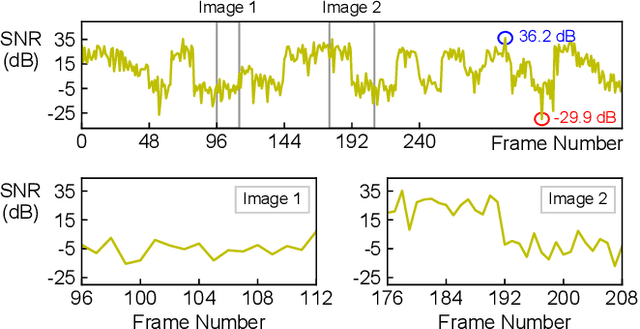
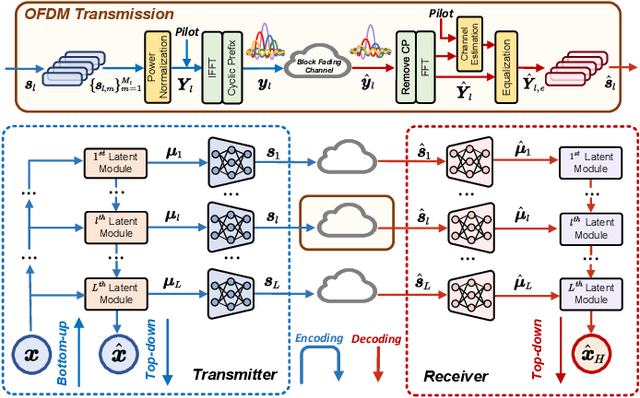
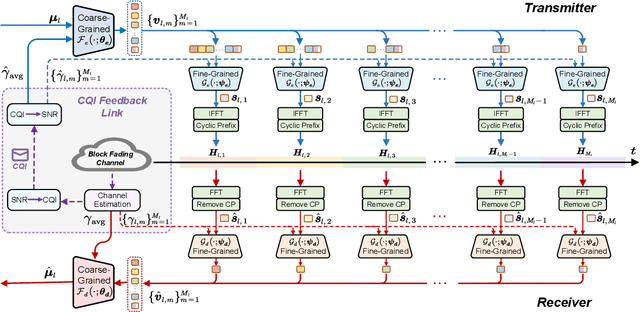
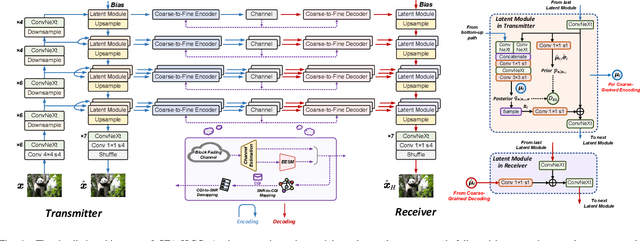
Abstract:Developing channel-adaptive deep joint source-channel coding (JSCC) systems is a critical challenge in wireless image transmission. While recent advancements have been made, most existing approaches are designed for static channel environments, limiting their ability to capture the dynamics of channel environments. As a result, their performance may degrade significantly in practical systems. In this paper, we consider time-varying block fading channels, where the transmission of a single image can experience multiple fading events. We propose a novel coarse-to-fine channel-adaptive JSCC framework (CFA-JSCC) that is designed to handle both significant fluctuations and rapid changes in wireless channels. Specifically, in the coarse-grained phase, CFA-JSCC utilizes the average signal-to-noise ratio (SNR) to adjust the encoding strategy, providing a preliminary adaptation to the prevailing channel conditions. Subsequently, in the fine-grained phase, CFA-JSCC leverages instantaneous SNR to dynamically refine the encoding strategy. This refinement is achieved by re-encoding the remaining channel symbols whenever the channel conditions change. Additionally, to reduce the overhead for SNR feedback, we utilize a limited set of channel quality indicators (CQIs) to represent the channel SNR and further propose a reinforcement learning (RL)-based CQI selection strategy to learn this mapping. This strategy incorporates a novel reward shaping scheme that provides intermediate rewards to facilitate the training process. Experimental results demonstrate that our CFA-JSCC provides enhanced flexibility in capturing channel variations and improved robustness in time-varying channel environments.
Learned Image Transmission with Hierarchical Variational Autoencoder
Sep 04, 2024



Abstract:In this paper, we introduce an innovative hierarchical joint source-channel coding (HJSCC) framework for image transmission, utilizing a hierarchical variational autoencoder (VAE). Our approach leverages a combination of bottom-up and top-down paths at the transmitter to autoregressively generate multiple hierarchical representations of the original image. These representations are then directly mapped to channel symbols for transmission by the JSCC encoder. We extend this framework to scenarios with a feedback link, modeling transmission over a noisy channel as a probabilistic sampling process and deriving a novel generative formulation for JSCC with feedback. Compared with existing approaches, our proposed HJSCC provides enhanced adaptability by dynamically adjusting transmission bandwidth, encoding these representations into varying amounts of channel symbols. Additionally, we introduce a rate attention module to guide the JSCC encoder in optimizing its encoding strategy based on prior information. Extensive experiments on images of varying resolutions demonstrate that our proposed model outperforms existing baselines in rate-distortion performance and maintains robustness against channel noise.
Rate-Adaptive Generative Semantic Communication Using Conditional Diffusion Models
Sep 04, 2024


Abstract:Recent advances in deep learning-based joint source-channel coding (DJSCC) have shown promise for end-to-end semantic image transmission. However, most existing schemes primarily focus on optimizing pixel-wise metrics, which often fail to align with human perception, leading to lower perceptual quality. In this letter, we propose a novel generative DJSCC approach using conditional diffusion models to enhance the perceptual quality of transmitted images. Specifically, by utilizing entropy models, we effectively manage transmission bandwidth based on the estimated entropy of transmitted sym-bols. These symbols are then used at the receiver as conditional information to guide a conditional diffusion decoder in image reconstruction. Our model is built upon the emerging advanced mamba-like linear attention (MLLA) skeleton, which excels in image processing tasks while also offering fast inference speed. Besides, we introduce a multi-stage training strategy to ensure the stability and improve the overall performance of the model. Simulation results demonstrate that our proposed method significantly outperforms existing approaches in terms of perceptual quality.
Digital Wireless Image Transmission via Distribution Matching
Jun 16, 2024Abstract:Deep learning-based joint source-channel coding (JSCC) is emerging as a potential technology to meet the demand for effective data transmission, particularly for image transmission. Nevertheless, most existing advancements only consider analog transmission, where the channel symbols are continuous, making them incompatible with practical digital communication systems. In this work, we address this by involving the modulation process and consider mapping the continuous channel symbols into discrete space. Recognizing the non-uniform distribution of the output channel symbols in existing methods, we propose two effective methods to improve the performance. Firstly, we introduce a uniform modulation scheme, where the distance between two constellations is adjustable to match the non-uniform nature of the distribution. In addition, we further design a non-uniform modulation scheme according to the output distribution. To this end, we first generate the constellations by performing feature clustering on an analog image transmission system, then the generated constellations are employed to modulate the continuous channel symbols. For both schemes, we fine-tune the digital system to alleviate the performance loss caused by modulation. Here, the straight-through estimator (STE) is considered to overcome the non-differentiable nature. Our experimental results demonstrate that the proposed schemes significantly outperform existing digital image transmission systems.
From Analog to Digital: Multi-Order Digital Joint Coding-Modulation for Semantic Communication
Jun 08, 2024
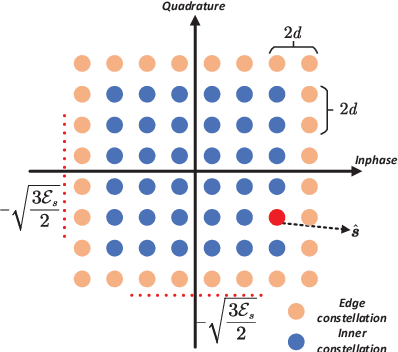
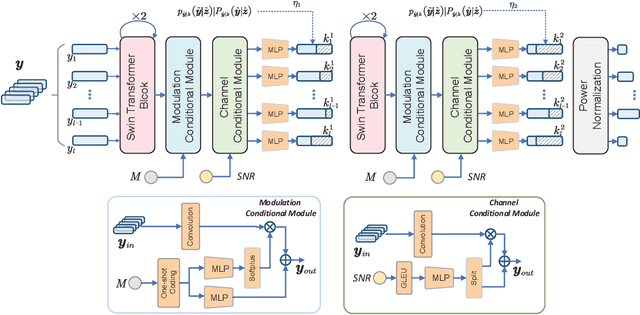
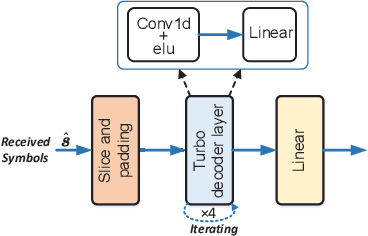
Abstract:Recent studies in joint source-channel coding (JSCC) have fostered a fresh paradigm in end-to-end semantic communication. Despite notable performance achievements, present initiatives in building semantic communication systems primarily hinge on the transmission of continuous channel symbols, thus presenting challenges in compatibility with established digital systems. In this paper, we introduce a novel approach to address this challenge by developing a multi-order digital joint coding-modulation (MDJCM) scheme for semantic communications. Initially, we construct a digital semantic communication system by integrating a multi-order modulation/demodulation module into a nonlinear transform source-channel coding (NTSCC) framework. Recognizing the non-differentiable nature of modulation/demodulation, we propose a novel substitution training strategy. Herein, we treat modulation/demodulation as a constrained quantization process and introduce scaling operations alongside manually crafted noise to approximate this process. As a result, employing this approximation in training semantic communication systems can be deployed in practical modulation/demodulation scenarios with superior performance. Additionally, we demonstrate the equivalence by analyzing the involved probability distribution. Moreover, to further upgrade the performance, we develop a hierarchical dimension-reduction strategy to provide a gradual information extraction process. Extensive experimental evaluations demonstrate the superiority of our proposed method over existing digital and non-digital JSCC techniques.
Feature Allocation for Semantic Communication with Space-Time Importance Awareness
Jan 26, 2024Abstract:In the realm of semantic communication, the significance of encoded features can vary, while wireless channels are known to exhibit fluctuations across multiple subchannels in different domains. Consequently, critical features may traverse subchannels with poor states, resulting in performance degradation. To tackle this challenge, we introduce a framework called Feature Allocation for Semantic Transmission (FAST), which offers adaptability to channel fluctuations across both spatial and temporal domains. In particular, an importance evaluator is first developed to assess the importance of various features. In the temporal domain, channel prediction is utilized to estimate future channel state information (CSI). Subsequently, feature allocation is implemented by assigning suitable transmission time slots to different features. Furthermore, we extend FAST to the space-time domain, considering two common scenarios: precoding-free and precoding-based multiple-input multiple-output (MIMO) systems. An important attribute of FAST is its versatility, requiring no intricate fine-tuning. Simulation results demonstrate that this approach significantly enhances the performance of semantic communication systems in image transmission. It retains its superiority even when faced with substantial changes in system configuration.
Deep Refinement-Based Joint Source Channel Coding over Time-Varying Channels
Nov 26, 2023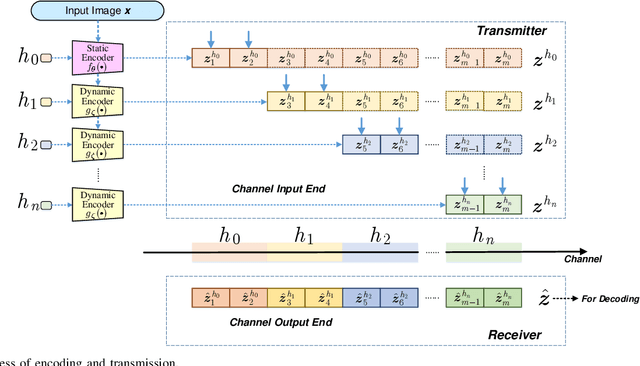
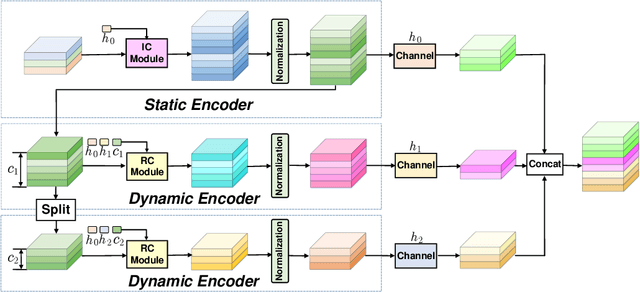
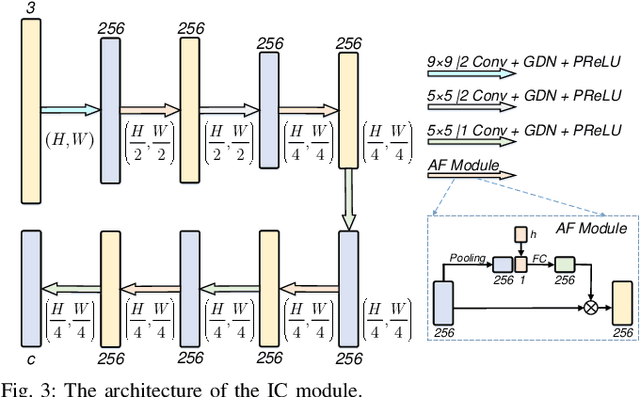
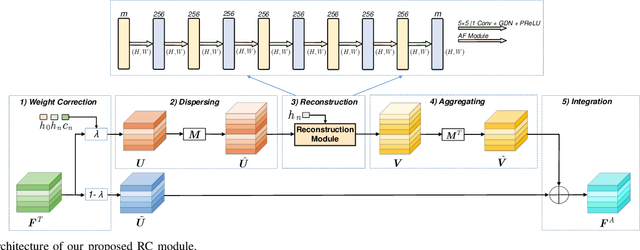
Abstract:In recent developments, deep learning (DL)-based joint source-channel coding (JSCC) for wireless image transmission has made significant strides in performance enhancement. Nonetheless, the majority of existing DL-based JSCC methods are tailored for scenarios featuring stable channel conditions, notably a fixed signal-to-noise ratio (SNR). This specialization poses a limitation, as their performance tends to wane in practical scenarios marked by highly dynamic channels, given that a fixed SNR inadequately represents the dynamic nature of such channels. In response to this challenge, we introduce a novel solution, namely deep refinement-based JSCC (DRJSCC). This innovative method is designed to seamlessly adapt to channels exhibiting temporal variations. By leveraging instantaneous channel state information (CSI), we dynamically optimize the encoding strategy through re-encoding the channel symbols. This dynamic adjustment ensures that the encoding strategy consistently aligns with the varying channel conditions during the transmission process. Specifically, our approach begins with the division of encoded symbols into multiple blocks, which are transmitted progressively to the receiver. In the event of changing channel conditions, we propose a mechanism to re-encode the remaining blocks, allowing them to adapt to the current channel conditions. Experimental results show that the DRJSCC scheme achieves comparable performance to the other mainstream DL-based JSCC models in stable channel conditions, and also exhibits great robustness against time-varying channels.
 Add to Chrome
Add to Chrome Add to Firefox
Add to Firefox Add to Edge
Add to Edge